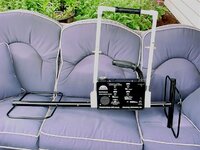Steven77
Greenie
Hello,
I have been researching a cache for the last 10 years and I think I now have its location narrowed down to about 2 football fields in size.
The cache is 2 saddlebags of gold coins buried over 100 years ago and it is buried about 4 feet deep in moderately minerized soil.
I would like some feedback from the members here – especially the cache hunters if they feel the Master Hunter CX Plus with the TreasureHound Depth Multiplier would find this target for sure?
As I’m sure you can understand, the very last thing I would want to happen is to pass over the top of the cache and miss it!
I know there are other types of units that can do the job but I am on a tight budget.
Regards,
Steven
I have been researching a cache for the last 10 years and I think I now have its location narrowed down to about 2 football fields in size.
The cache is 2 saddlebags of gold coins buried over 100 years ago and it is buried about 4 feet deep in moderately minerized soil.
I would like some feedback from the members here – especially the cache hunters if they feel the Master Hunter CX Plus with the TreasureHound Depth Multiplier would find this target for sure?
As I’m sure you can understand, the very last thing I would want to happen is to pass over the top of the cache and miss it!
I know there are other types of units that can do the job but I am on a tight budget.
Regards,
Steven








